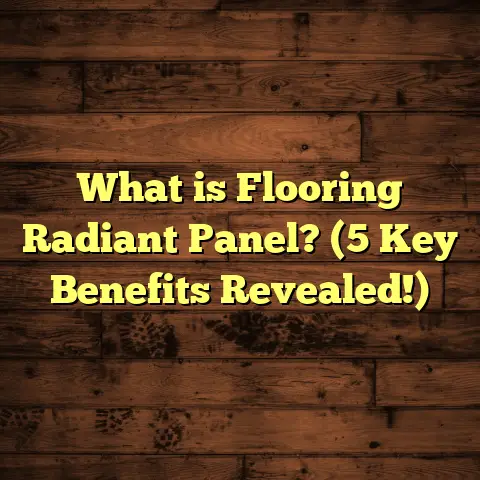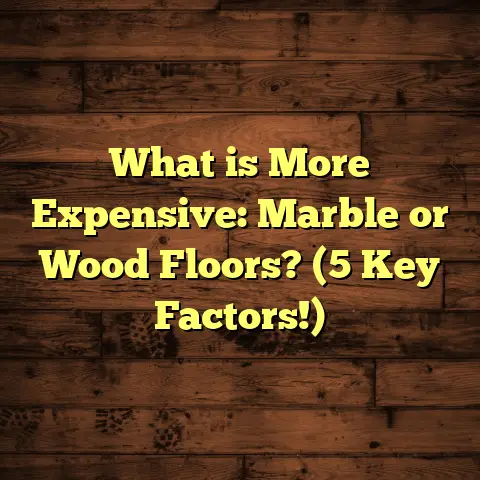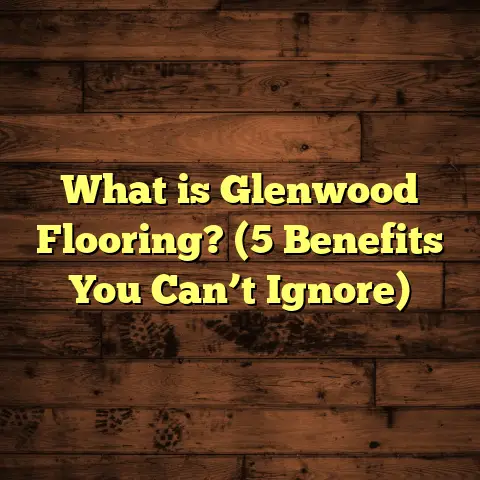What is VCT Tile Flooring? (5 Key Benefits You Need to Know)
Have you ever stepped into a school hallway or an old hospital corridor and noticed those shiny, square tiles on the floor? Maybe you ran your fingers over them or admired their bright colors. For me, seeing those floors brings back a wave of nostalgia. I remember walking through my elementary school corridors where those VCT tiles were everywhere—durable, colorful, and somehow comforting. Over the years, I’ve come to appreciate these tiles not just for their look but for what they bring to any space. So, what exactly is this VCT tile flooring that’s been around for decades yet still remains popular?
What is VCT Tile Flooring?
Vinyl Composition Tile, or VCT, is a type of resilient flooring made primarily from vinyl resin combined with limestone and other additives pressed into square tiles. Typically, these tiles come in 12-by-12-inch sizes, although other sizes exist. The mixture of materials creates a tough yet flexible floor covering that is able to withstand heavy foot traffic while offering a wide range of colors and patterns.
Unlike sheet vinyl flooring, which comes in large rolls, VCT consists of individual tiles glued down to a subfloor. This modularity makes it easy to replace damaged tiles without tearing up an entire floor. The surface of VCT is usually matte when freshly installed, but a glossy finish is achieved through waxing and buffing.
When I first started working as a flooring contractor, I was curious why so many institutional buildings—from schools to hospitals—preferred VCT. After installing it multiple times myself and speaking with other industry professionals, I realized that VCT’s cost-effectiveness and durability were unmatched in commercial settings.
How Is VCT Made?
The manufacturing process involves mixing powdered limestone for bulk, vinyl resins for flexibility and resilience, pigments for color, and additional fillers for stability and strength. This raw mixture is then heated and pressed into sheets which are cut into individual tiles.
The limestone filler makes the tile heavier but also sturdier compared to pure vinyl tile. The resin binds everything together and gives the tile its resilient properties—meaning it can bend slightly without cracking. Pigments provide color throughout the tile, so scratches don’t reveal a different base color like some other materials.
What Does VCT Look Like?
Many people picture VCT as plain checkerboard black and white squares—a staple in old school hallways. But modern VCT has evolved with countless color options and patterns available now. You can find tiles with earth tones, vibrant blues, greens, reds, and neutral grays. Some manufacturers even offer tiles that mimic natural stone or wood grain.
In fact, I recently helped a client design a retail space with custom VCT patterns that matched their brand colors. It was impressive how flexible these tiles could be aesthetically.
1. Durability That Stands the Test of Time
Why do so many schools and hospitals still rely on VCT after so many years? The key lies in durability.
VCT is designed to handle heavy foot traffic daily without wearing out quickly. This makes it perfect for places where thousands of feet walk over it every day. The limestone filler adds strength while the vinyl resin provides enough flexibility to resist cracking.
According to data from the National Floor Safety Institute and various industry reports:
- VCT floors can last between 15 to 20 years in commercial spaces with proper maintenance.
- In contrast, carpet floors might last only 5-7 years before needing replacement.
- Hardwood floors in high traffic areas require refinishing every 5-10 years.
I’ve personally seen VCT floors installed in local community centers over 15 years ago still looking great today after routine waxing and buffing treatments. That kind of lifespan can’t be ignored when budgeting for long-term flooring solutions.
Real Case Study: Community College Flooring
At a community college where I was contracted to replace worn-out flooring in classrooms and hallways, the choice was clear—VCT offered the durability needed for high student traffic at a reasonable price. After installing approximately 10,000 square feet of VCT tiles and conducting regular maintenance training with staff, the floors remained visually appealing five years later despite thousands of students walking daily.
2. Cost-Effective Flooring Solution
One of the most frequent questions I get is about cost—how much does VCT cost compared to other flooring options?
Here’s what I usually tell people based on recent market data:
- Material costs: $2 – $5 per square foot
- Installation costs: $1 – $3 per square foot depending on labor rates and site prep
- Total estimated cost: $3 – $8 per square foot installed
For a 1,500-square-foot commercial space, this means you can expect to pay roughly $4,500 to $12,000 all-in.
That’s quite competitive compared to hardwood flooring (which can run $8-$15 per square foot installed) or ceramic tile ($5-$10). Plus, when factoring in longevity and maintenance requirements, VCT often represents a better value over time.
Many clients with tight budgets find that VCT allows them to balance durability and aesthetics without overspending. For example, I once worked with a non-profit youth center aiming to refurbish their floors on a tight budget. They wanted something visually appealing but practical. VCT was the perfect fit—they got vibrant colors and lasting durability within their financial constraints.
3. Easy Maintenance With Regular Care
People sometimes worry that vinyl floors require complicated upkeep—but that’s not true for VCT if you follow some simple steps.
Here’s what maintenance looks like:
- Daily: Sweep or dust mop to remove dirt and grit that could scratch the surface.
- Weekly: Damp mop with a neutral cleaner.
- Every few months: Strip old wax layers off using a chemical stripper then apply new coats of wax.
- Occasionally: Buff floors with a high-speed burnisher to restore shine.
Waxing is crucial because VCT doesn’t come pre-waxed from the factory; the wax layer protects the tile from scuffs and stains while enhancing appearance.
In my experience managing maintenance schedules for office buildings, floors receiving regular waxing cycles showed far fewer scratches and lasted longer before needing replacement compared to neglected spots.
Maintenance Costs: What To Expect
While some worry waxing might add up cost-wise, it’s actually quite affordable:
- Stripping chemicals: $25-$50 per gallon (enough for hundreds of square feet)
- Wax: $30-$60 per gallon
- Labor for waxing: $0.20-$0.50 per sq ft depending on size
An annual budget of around $0.50 per square foot for maintenance often keeps VCT floors looking new for years.
4. Design Versatility
You might be surprised how versatile VCT tiles can be.
Instead of dull solid colors or simple checkerboards, manufacturers now offer:
- A wide spectrum of colors: from subtle neutrals to bright hues
- Patterns: geometric shapes, stripes, mosaics
- Texture effects: options that mimic stone or wood grain
- Custom designs: made-to-order tile patterns matching logos or branding
For example, I recently collaborated with a boutique retailer who wanted their floor to stand out without compromising durability or budget. Using custom-cut VCT tiles in blues and grays arranged in an abstract pattern gave their store a modern look while handling heavy foot traffic easily.
Color Retention Over Time
Unlike painted surfaces that fade quickly under sunlight or wear down unevenly, VCT’s color comes from pigments mixed throughout the tile’s body. This means even if the surface wears slightly or scratches appear over time, color remains consistent beneath wax layers.
5. Environmentally Friendly Options
You might wonder how vinyl fits into an eco-conscious world. Vinyl materials have long been criticized for environmental impact during production and disposal. However, recent advances have improved sustainability in multiple ways:
- Some manufacturers now include post-consumer recycled vinyl chips in their compositions.
- The long lifespan of VCT means fewer replacements and less waste generation.
- Many VCT products meet low-VOC (volatile organic compounds) standards contributing to healthier indoor air quality.
- Using VCT can contribute points toward LEED certification in commercial projects due to recycled content and low emissions.
The Resilient Floor Covering Institute (RFCI) reports that modern resilient flooring—including VCT—can reduce environmental impact when compared across its lifecycle with alternatives like carpet or wood.
My Personal Story With VCT Flooring
Years ago, I was hired by a local library board to install new flooring throughout their reading rooms and corridors. The existing floors were old linoleum sheets badly damaged by years of foot traffic and spills.
The library needed something durable but budget-conscious since public funding was limited. After discussing options with the board and facility managers, we settled on VCT tiles due to their proven resilience and ease of maintenance.
We prepped the concrete slab with care—cleaning thoroughly and leveling minor imperfections—to ensure smooth tile installation. Over several days we laid down thousands of tiles with precision adhesive application.
After installation came the waxing stage—multiple coats applied then buffed until shiny. I remember the staff marveling at how bright and polished their new floors looked under the library lights.
Two years later during a follow-up visit, I was pleased to see minimal wear despite heavy daily use by children and adults alike. The library staff had kept up with recommended maintenance routines which preserved floor appearance beautifully.
This project reinforced for me why VCT remains one of my favorite flooring choices for commercial spaces requiring longevity combined with affordability.
Installation Tips From My Experience
While installing VCT isn’t overly complicated compared to some flooring types like hardwood or stone tile, getting it right demands attention:
Subfloor Preparation Is Everything
The subfloor should be:
- Completely clean (no dust or debris)
- Dry (moisture can cause adhesive failure)
- Level within 1/8 inch over 6 feet (uneven surfaces cause lippage or hollow spots)
Ignoring this step risks tile lifting or cracking prematurely.
Acclimate Tiles Before Installation
VCT tiles should be stored on-site at room temperature for at least 24 hours before installation so they adjust to humidity levels. This prevents expansion or contraction after being glued down.
Adhesive Application
Use high-quality adhesive recommended by the manufacturer designed specifically for vinyl composition tile. Apply evenly with a notched trowel ensuring full coverage but avoiding puddles.
Tile Alignment
Start from the center of the room or a prominent straight edge and work outward symmetrically to avoid awkward cuts along walls.
Rolling And Pressing
Once tiles are placed on adhesive, use a floor roller (preferably 100 lbs) to press each tile firmly ensuring good bonding without air pockets.
Post-installation Care
Wait recommended curing time (usually 24-48 hours) before heavy foot traffic or waxing begins.
How Does VCT Stack Up Against Other Popular Flooring Types?
| Flooring Type | Durability | Cost per Sq Ft | Maintenance | Design Variety | Environmental Impact |
|---|---|---|---|---|---|
| VCT | High (15-20 years) | $2 – $5 | Moderate (waxing) | Wide range/colors | Improved with recycled content |
| Hardwood | Moderate-High | $8 – $15 | Requires refinishing | Excellent natural look | Renewable but requires trees |
| Laminate | Moderate | $3 – $8 | Low | Limited | Synthetic; less recyclable |
| Ceramic Tile | Very High | $5 – $10 | Low | Excellent | Durable but energy-intensive |
| Carpet | Low-Moderate | $2 – $7 | High (cleaning) | Many patterns | Synthetic fibers; waste issues |
If you want a low-cost floor that will last long and can be customized easily—VCT wins out often in commercial settings.
Common Questions I Get About VCT Flooring
Q: Can you install VCT over existing floors?
A: Usually no. Proper installation requires removal of old flooring down to the subfloor to ensure adhesion and longevity.
Q: Is it waterproof?
A: Not fully waterproof but water-resistant if sealed properly with wax. Standing water should be avoided as it can seep through grout lines or seams.
Q: How slippery is it?
A: When freshly waxed or wet it can be slick; using slip-resistant finishes or mats helps mitigate this risk.
Q: Can damaged tiles be replaced easily?
A: Yes! One big advantage is patch repair—just remove damaged tiles carefully and glue down replacements without disturbing surrounding areas.
Troubleshooting Common Issues With VCT
Even durable floors like VCT face occasional problems. Here’s what I’ve learned about troubleshooting:
Tiles Lifting Or Curling
Most often caused by improper adhesive application or moisture underlayment issues. Fix by removing affected tiles, drying subfloor thoroughly, then reapplying adhesive correctly.
Scratches And Scuffs
Regular waxing helps protect surface but heavy furniture dragging needs felt pads under legs to avoid damage.
Yellowing Or Discoloration
Can happen if wrong cleaning chemicals are used or excessive heat exposure occurs. Use manufacturer-approved cleaners only.
Design Ideas To Make Your VCT Floor Pop
If you want your floor to do more than just stand up underfoot here are some creative ideas:
Pattern Play
Combine different colored tiles in geometric shapes like diamonds or herringbone patterns for visual interest.
Brand Colors Or Logos
Custom-cut tiles arranged in company logos make strong branding statements in lobbies or retail stores.
Borders And Insets
Create frames around certain areas such as reception desks using contrasting colors or textures.
Mixed Materials
Pair VCT sections with other flooring types like carpet squares or hard wood strips for unique effects.
Final Thoughts From My Flooring Journeys
Over my years working hands-on with all kinds of flooring materials, few products have impressed me like VCT for delivering value at multiple levels—durability, cost-effectiveness, maintenance ease, design flexibility—and even environmental improvements lately.
When you see those brightly colored squares lining school hallways or hospital corridors again, you’re looking at decades of proven performance combined with adaptability that meets today’s design trends too.
If you need flooring that’s tough enough for crowds but won’t empty your wallet nor demand constant repair—VCT is definitely worth exploring as your next floor covering choice!




